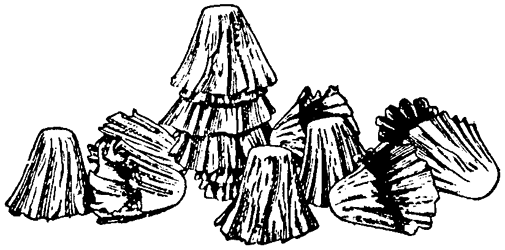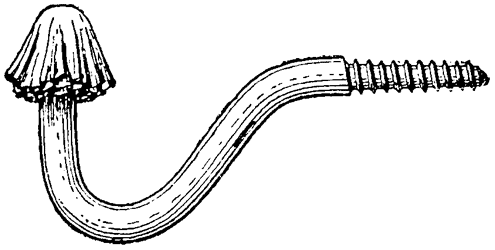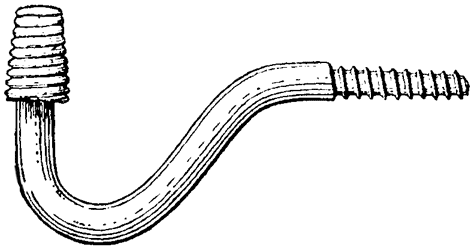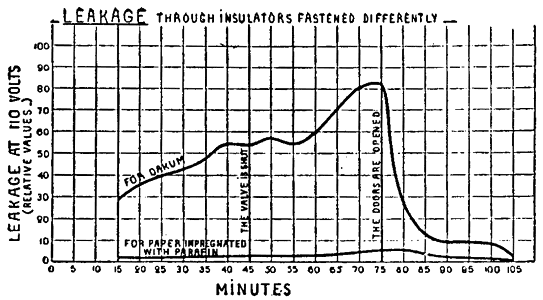[Trade Journal]
Publication: The Electrician
New York, NY, United States
p. 804-805, col. 2, 1
NEW METHOD- OF FASTENING INSULATORS.* (1)
BY CARL EGNER.
The method which is most used at present for fastening an insulator to its support consists, as is well known, in the support being wound round with black oakum, or the like, after which the insulator is screwed on over the oakum. This latter material does not contribute in the least to the insulation, but, on the contrary, diminishes it to a considerable degree as filaments of the oakum often hang down and serve to conduct the electric current from the lower part of the insulator to the support. The fixing by means of black oakum needs great practice, as a workman unaccustomed to the work finds it difficult to fasten the insulator properly, in addition to which the insulator easily cracks into pieces if the necessary caution is not observed.
In the new method of fastening the insulator the inconveniences just mentioned are obviated, at the same time certain advantages are obtained, as will be shown below.
The essential part of the new method is the use of insulating caps, which consist of extra strong durable paper, impregnated with insulating material. The form of the insulator caps is illustrated in Fig. 1, and the way in which they are used in Figs. 2 and 3.
 |
| Fig. 1. |
The insulating caps arc placed to the requisite number upon the support, the one upon the other (Fig. 2), and are pressed together somewhat by the hand, so that there will be no great space between The insulator is then screwed on while simultaneously being pressed against the support. The paper is thus pressed together, so that it quite fills the space between the support and the inner threaded part of the insulator, as is illustrated in Fig. 3, where the support with the insulating caps is shown after the insulator has been first fastened on and then screwed off. The number of caps which is required is ascertained by trial for each special kind of insulator and support. The thickness of the paper is preferably so chosen that four to five caps have to be used for each insulator.
It will improve the insulation if, before the insulator is screwed on, there is put inside the same some drops of an oil which will not become rancid, such as paraffin oil, which can, if desired, be mixed with raw linseed oil. For this purpose a small oil can can be used.
 |
| Fig. 2. |
The particular advantage of the insulating caps is the greatly improved insulation. This increase in insulation is due to a great extent to the fact that the space between the support and the inner mantle of the insulator is always free from filaments and the like, in contrast to the state of things when black oakum is used. Another cause of the improved insulation is that the insulating caps cover the support not only at the side but also at the top with a watertight, insulating mass. Thus a crack in the upper part of the insulator does little or no harm. A large number of experiments have also proved that the insulator can be broken off at the top, so that the hole for the support becomes visible without the insulation being affected in any noticeable degree, at least for some length of time. This fact is of the greatest importance in all places where the insulators are exposed to damage, and also in places where, for instance, insulators which have not been separately tested are used for the support of low-tension current conductors, as among such insulators there are not a few which have fine cracks extending through the same and causing leakage of current in bad weather.
A third and very essential cause of the improved insulation which is obtained by the use of insulating caps is that they are impregnated with an oily insulating material, whereby the insulators are made to act as oil insulators. The oily, creased surface of the lowest part of the caps, between the support and the insulator, offers a very great resistance to surface leakage, and as tins surface is the best protected part within the insulator, it can keep clean and act for a long period. It is clear, however, that, by degrees, the oil will get dirty by dust, &c., and that the insulation will diminish. But, for the reasons mentioned above, the insulation will always be greater than if black oakum is used, and it can easily again be increased by unscrewing the insulator and putting on new caps, or, if desired, by again soaking the old ones in oil. This would be a most advantageous method of proceeding, especially in the case of important low-tension conductor, as, for example, long telephone lines.
 |
| Fig. 3. |
A well-known cause which contributes to the deterioration of insulation, always noticed on old conducting lines, is that spiders and other insects frequent the places on the underside of the insulator, between the mantles and the support. This inconvenience can to some extent be remedied, where insulating caps are employed, by adding birch oil or some other substance the odour of which is avoided by insects to the material with which the caps are impregnated. This has, however, not been tested in practice.
Insulating caps have also other advantages besides the increase in insulation, and the first thing to be noticed is that the mounting of the insulators is greatly facilitated. Experiments have proved that, when insulating caps are used, the mounting takes only half the time which is required when black oakum is used, while little or no practice is needed to do the work.
In addition to this, insulators with insulating caps will always be mounted concentrically in respect to the support, for the reason that the material in the caps automatically spreads itself equally round the support when the insulators are screwed on.
 |
| Fig. 4. |
Experience has also proved that breakage of insulators, when these are being mounted, seldom or never occurs when insulating caps are used, which is of considerable importance.
Finally, it should be mentioned that the unscrewing of the insulators from the supports is considerably facilitated by this new method of mounting the same, a fact of great importance on lines where the insulators are much exposed to soot and smoke, and must consequently often be taken down to be cleaned.
In order to show in what degree insulating caps affect the insulation, a diagram (Fig. 4) is reproduced, showing tests carried out by the Material Testing Department of the Royal Technical College, to show the difference between insulators fastened with oakum and some insulators fastened with insulator caps.
The tests were made in a rain-chamber, and the diagram shows the leakage, partly during the rain, partly for a time after the rain had ceased. From the curves shown it will be seen that the paper fastenings gave when the leakage was highest more than 10 times as good a result as the oakum fastenings.
(1) Translated from the Teknisk Tidskrift.
